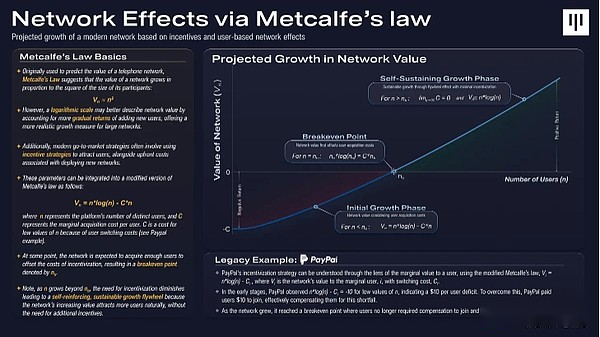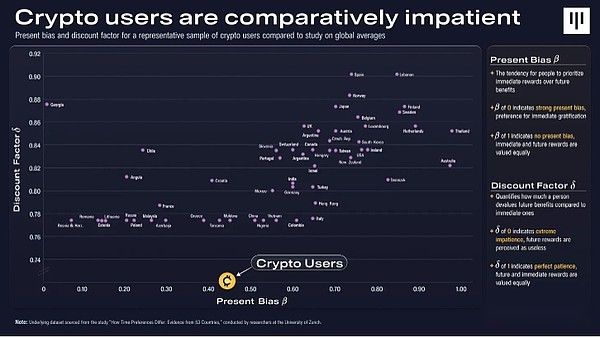
Author: Paul Veradittakit, Managing Partner, Pantera Capital, compiled by: Wuzhu, Bitchain Vision
summary
-
A study from Pantera Research Lab found that cryptocurrency users exhibited higher current bias and lower discount factors, indicating their strong preference for instant gratification.
-
The quasi-hyperbolic discount model is characterized by parameters such as current bias (ꞵ) and discount factor (?), which helps to understand the tendency of individuals toward immediate returns rather than future returns, which is turbulent and speculatively encrypted.This is particularly evident in the money market.
-
This research can be used to optimize token allocations, such as airdrops for rewarding early users, decentralized governance, and marketing new products.
Preface
A classic story of Silicon Valley startup legend is that Paypal decided to pay $10 to users who use its products.The reason is that if you can pay the user for joining, the network value will eventually become high enough that new users will join for free and you can stop paying.This does seem to work because PayPal is able to stop paying and continue to grow, thereby launching its network effect.

In the cryptocurrency space, we have adopted and expanded this approach, by airdropping, not only paying fees to those who join, but also often to those who have used our products for a while.
Pseudo-hyperbolic discount model
Airdrops have become a multifaceted tool for rewarding early users, decentralized protocol governance, and frankly, marketing new products.Formalizing the standard of distribution has become an art, especially when determining who should receive the reward and the value their efforts deserve.In this case, the number of tokens distributed and the time of release (usually through mechanisms such as attribution or gradual release) plays an important role.These decisions should be based on systematic analysis rather than relying on guesswork, sentiment, or precedent.Using a more quantitative framework ensures equity and is aligned with long-term goal strategies.
The quasi-hyperbolic discounting model provides a mathematical framework for exploring how individuals make choices involving reward trade-offs at different times.Its application is particularly important in areas where impulses and inconsistencies significantly affect decision-making over time, such as financial decisions and health-related behaviors.
The model is driven by two population-specific parameters: the current deviation ꞵ and the discount factor?.
Current bias (ꞵ):
This parameter measures individuals’ tendency to prioritize instant rewards over long-term rewards.This parameter varies between 0 and 1, where 1 indicates no immediate bias, reflecting the balanced, time-consistent assessment of future rewards.When values approach 0, they indicate an increasing immediate bias, indicating an increased preference for immediate rewards.
For example, if you want to choose between $50 today and $100 a year later, people with higher instant bias (nearly 0) will choose to get $50 right away instead of waiting for a bigger amount.
Discount factor (?):
This parameter describes the rate at which the value of future rewards decreases with the increase in realization time, explaining why its perceived value naturally decreases with delay.Discounting factors are quantified more accurately over longer multi-year intervals.This factor exhibits considerable variability when evaluating both options in the short term (less than a year), as instant situations disproportionately affect perception.
For the general population, studies show that the discount rate is usually around 0.9.However, this value is usually much lower in groups with gambling tendencies.Research shows that the average discount factor for habitual gamblers is usually slightly below 0.8, while the discount factor for problem gamblers tends to be close to 0.5.
Using the above terms, we can express the utility of obtaining a reward x at time t by the following formula U:
U(t) = tU(x)
This model captures how the value of a reward varies according to its time: Instant rewards are evaluated on full utility, while future rewards are adjusted downwards, taking into account current bias and exponential decay.
experiment
Last year, Pantera Research Lab conducted a study to quantify the behavioral tendencies of cryptocurrency users.We asked participants two simple questions to target whether they prefer to pay immediately or to gain some future value.
This method helps us determine the representative values of ꞵ and ?.Our results show thatRepresentative samples of cryptocurrency users exhibited a present deviation slightly above 0.4 and a significantly lower discount coefficient.

Research shows that cryptocurrency users have higher than average current bias and lower discount rates, indicating that they tend to be impatient and prefer instant gratification over future gains.
This can be attributed to several interrelated factors in the cryptocurrency space:
-
Cyclic market behavior:The cryptocurrency market is known for its volatility and cyclicality, and the value of tokens often fluctuates rapidly.This cyclicality affects user behavior, as many people are used to shuttle through these cycles rather than adopting the longer-term investment strategies that are more common in traditional finance.Frequent ups and downs may lead to higher discount rates for future value, fearing that potential downturns may erase profits.
-
Token stigma:The survey specifically asked about the tokens and their expected future value, which could highlight the deep-rooted stigma associated with token-specific transactions.This stigma is related to the cyclical and speculative nature of token valuations, strengthening cautious attitudes towards long-term investment in the cryptocurrency sector.Furthermore, it is assumed that the survey uses fiat currency or other forms of reward to measure preference.In this case, discount rates for cryptocurrency users may be closer to the global average, suggesting that the nature of the reward may significantly affect the observed discount behavior.
-
Speculative nature of crypto applications:Today’s crypto ecosystem is deeply rooted in speculation and trading, and these characteristics are ubiquitous in its most successful applications.This trend highlights that most current users prefer speculative platforms, and the survey results also reflect this preference, indicating that users have a strong tendency to obtain instant financial returns.
While the findings may differ from typical human behavior norms, they reflect the characteristics and trends of the current crypto user base.This distinction is especially important for projects that design airdrops and token allocations, as understanding these unique behaviors allows for more strategic planning and reward system construction.
Take the perps DEX Drift approach on Solana, which recently launched its native token, DRIFT.The Drift team includes a delay mechanism in its token allocation strategy, offering double rewards to users who wait for 6 hours to receive airdrops after token release.The increased time delay is to alleviate congestion usually caused by robots at the start of the airdrop and potentially help stabilize the performance of the token by reducing the initial surge in sellers.
In fact, only 7500 (i.e. 15%) (at the time of writing) prospective recipients did not wait 6 hours to double their rewards.According to the research we proposed, Drift could be delayed by several months if the reward value doubles, and statistically, it should be able to appease most end users.








